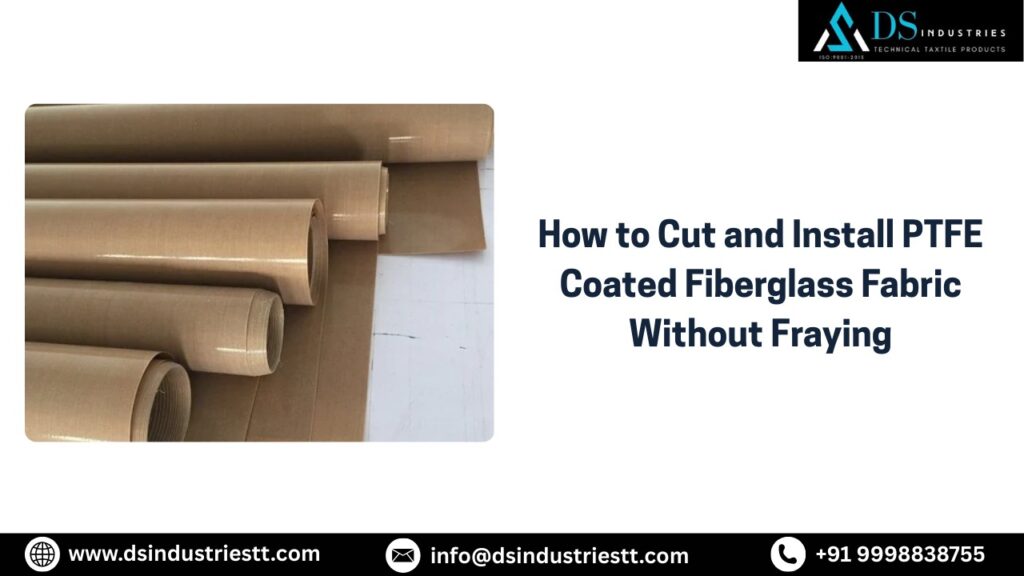
PTFE coated fiberglass fabric is widely used in industrial applications due to its excellent heat resistance, chemical resistance, non-stick surface, and mechanical strength. Whether used for insulation covers, conveyor belts, or protective barriers, proper cutting and installation are essential to maintain the material’s performance and prevent fraying.
Fraying can lead to edge breakdown, contamination, and reduced durability. Fortunately, with the right tools and techniques, you can cut and install PTFE coated fiberglass fabric cleanly and efficiently.
Here’s a step-by-step guide to help you get it right.
1. Choose the Right Tools
To ensure a clean cut without fraying, use sharp tools designed for cutting fiberglass fabric:
- Hot Knife or Heated Blade: A hot knife seals the fabric edge as it cuts, preventing fraying and unraveling.
- Scissors with Teflon Coating: If a hot knife isn’t available, use heavy-duty Teflon-coated scissors. While these may not seal edges, they provide smooth, accurate cuts.
- Rotary Cutter: Ideal for cutting long, straight sections when used with a cutting mat and metal ruler.
Avoid dull blades or utility knives, which may tear or damage the fabric.
2. Prepare the Work Area
Before cutting, prepare a clean, flat surface. Use a non-slip cutting mat to stabilize the material and protect your tools. Mark the fabric lightly using a chalk line or fabric marker—avoid pens or inks that may damage or stain the PTFE surface.
3. Use Edge Sealing Techniques
If you’re not using a hot knife, consider applying edge sealing methods after cutting:
- PTFE Coated Heat-Sealing Tape: Apply this to the fabric’s edges to prevent fraying.
- High-Temperature Silicone or Adhesive: A light coating on the edge can help seal fibers and improve longevity.
- Sewing with PTFE Thread: For applications requiring stitching, use PTFE thread to maintain heat resistance and strength.
4. Proper Installation
When installing PTFE coated fiberglass fabric, consider the following tips:
- Avoid Overstretching: Fiberglass fabric is stable but can distort if pulled excessively during installation.
- Use Grommets or Fasteners: Reinforce mounting points with grommets or clamps to prevent tearing at contact areas.
- Maintain Tension Evenly: Ensure uniform tension when fastening to avoid wrinkles or fabric stress.
Always follow manufacturer guidelines regarding temperature tolerance and installation conditions.
5. Maintenance Tips
To keep the fabric in good shape post-installation:
- Clean Gently: Wipe with a soft cloth and mild cleaner to remove dust or buildup.
- Inspect Regularly: Check for edge wear or delamination and reapply edge sealant if necessary.
- Avoid Sharp Contact: Prevent damage from sharp tools or rough surfaces nearby.
Conclusion
Cutting and installing PTFE coated fiberglass fabric without fraying is simple when you use the right tools and follow proper techniques. Whether in industrial, commercial, or custom applications, these steps help ensure a clean, professional finish and maximize the lifespan of this high-performance material.
FAQ :
1. What is the best way to cut PTFE coated fiberglass fabric?
Using a hot knife or heated blade is the best method. It cuts and seals the edges simultaneously, preventing fraying and maintaining the fabric’s durability and clean finish.
2. Can I use regular scissors to cut PTFE coated fiberglass fabric?
Yes, but it’s not ideal. Heavy-duty, Teflon-coated scissors can work for small jobs, but they may cause frayed edges. For best results, use a hot knife or apply edge sealant after cutting.
3. How do I prevent the fabric from fraying after cutting?
Use a hot knife during cutting, or apply PTFE-coated edge sealing tape or high-temperature silicone adhesive on the cut edges to keep the fiberglass from unraveling during use.
4. What surface should I use while cutting the fabric?
Always work on a flat, stable surface like a cutting mat. It provides grip, protects tools, and ensures accurate, clean cuts without slipping or damaging the fabric.
5. How should I install PTFE coated fiberglass fabric?
Avoid overstretching the fabric. Use grommets, clamps, or reinforced edges for secure mounting. Maintain even tension across the surface to prevent wrinkles and edge damage during installation.
6. Is it necessary to seal the edges after cutting?
Yes, especially if you don’t use a hot knife. Sealing prevents fiber shedding, fraying, and contamination, extending the life and performance of the fabric in industrial applications.


